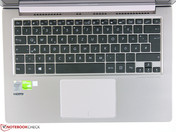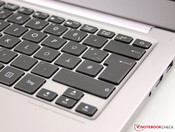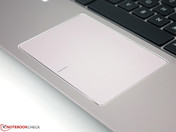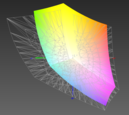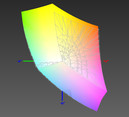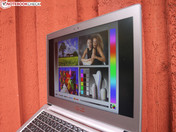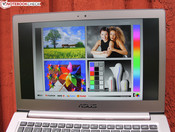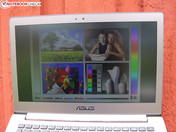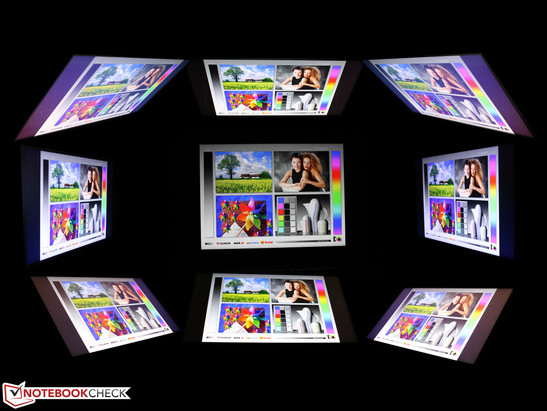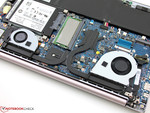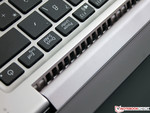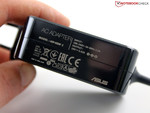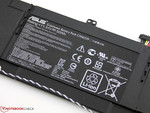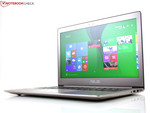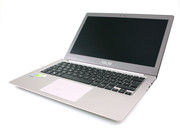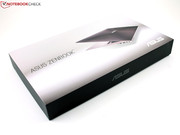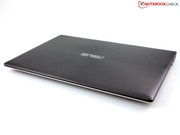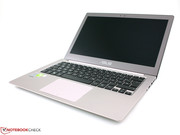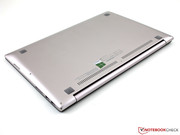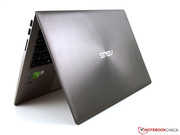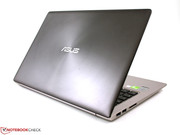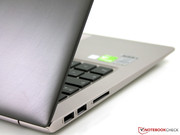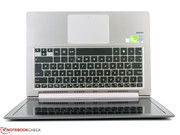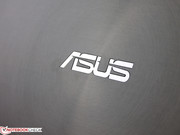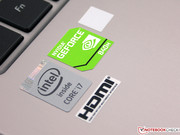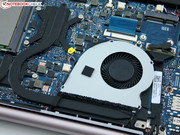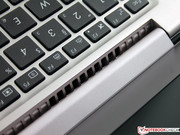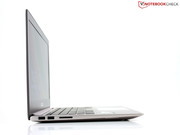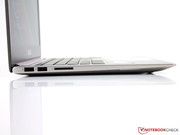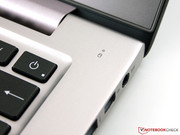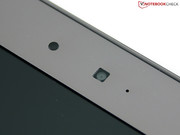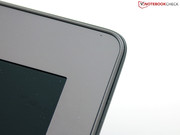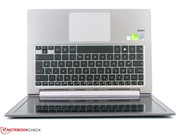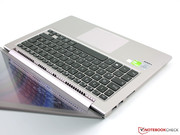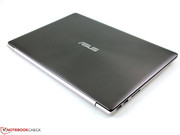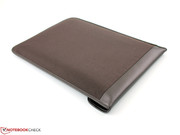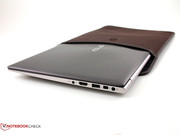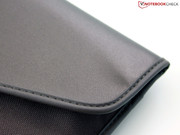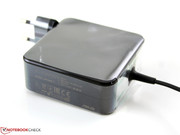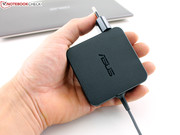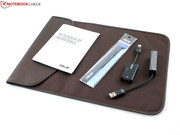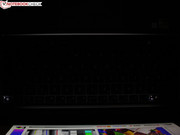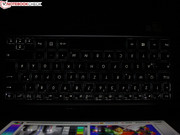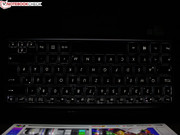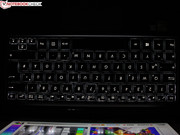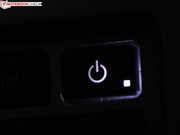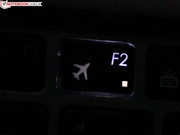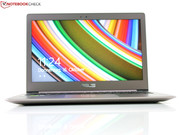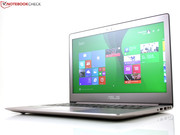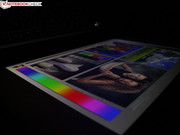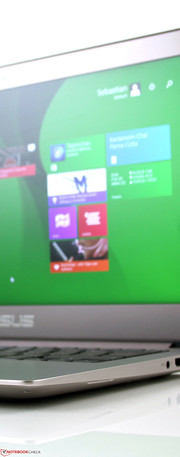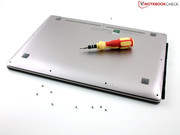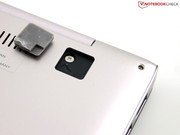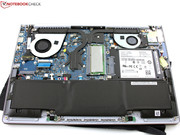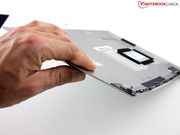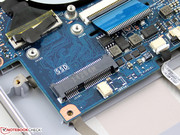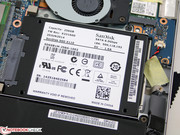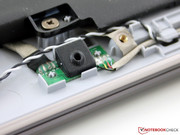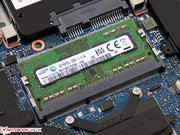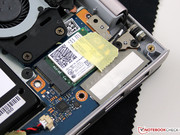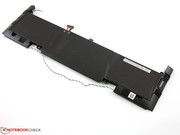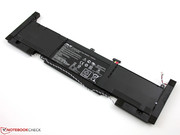Asus Zenbook UX303LN-R4141H Subnotebook Review

For the original German review, see here.
Asus goes into the second round. Subsequent to the disappearance of the successful 13-inch Zenbooks UX32LN-R4053H (840M), UX32LN-R4029H (840M), and UX32LA-R3025H (IGP) after only six months in the market, their successor, Zenbook UX303LN is at the start. The extremely short commercial presence of the UX32 models is puzzling because they were slim, solid subnotebooks that Asus offered as both entry-level (HD, IGP, matte TN) and high-end (FHD, 840M, matte IPS) models. The successor, now available, is also equipped with a Haswell chip as well as a GeForce 840M. Why the first generation was not maintained defies explanation because as the saying goes: "Never change a winning team".
Most 13 to 14-inch competitors do not feature a dedicated graphics card. Acer's Aspire S3-392G (GT 735M) from early 2014 has been discontinued in Germany. However, Lenovo's IdeaPad U430 Touch (GT 730M, 800 Euros;~$1013) from late summer 2013, which combines a rigid, quality aluminum unibody with a graphics card, is still available.
Only IGP devices are found in the below 1200 Euros (~$1520) range, some even with a matte screen. For example, Apple's MacBook Pro Retina 13, that can also render games satisfactorily owing to the HD Graphics 5100. Gigabyte has the 14-inch P34G v2 with a GeForce GTX 860M for slightly more. It is a handy gaming laptop that most definitely cannot pass as an ultrabook in terms of ergonomics and dimensions. However, our non-touch review sample is not one either.
1200 Euros (~$1520) or less:
· Apple MacBook Pro Retina 13 (HD Graphics 5100, 1200 Euros; ~$1520))
· Toshiba Portégé Z30-A-12U (matte TFT, 1000 Euros; ~$1266)
· Samsung ATIV Book 9 Style (matte TFT, 1000 Euros; ~$1266)
· Lenovo IdeaPad U430 Touch (GT 730M, 800 Euros; ~$1013)
1250 Euros (~$1583) or more
· Dell XPS 13 (1300 Euros; ~$1646)
· HP Spectre 13-3010eg (touch, 1350 Euros; ~$1710)
· Gigabyte P34G v2 (matte, GTX 860M, 1250 Euros; ~$1583)
Case
The casing of the Zenbook UX32LN/LA has been adopted entirely; the modifications that have been made in appearance are minimal and virtually invisible. We only discovered that one USB port has been moved from the right to the left, and that the microphones are now on the very front underside (two small holes). The underside is no longer brushed (textured), but is painted like the C-cover (work area). The stability and build quality is absolutely identical to that of the Zenbook UX32LN/LA, and therefore we will not go into details about it here. The base is milled from one piece of light metal, and has a plastic inlay (components' carrier). The base plate made of thin aluminum is screwed to the bottom tray.
Connectivity
The interfaces have been positioned appropriately in the rear areas of the sides, which largely prevents interfering with an external mouse when used.
Communication
Intel's Wireless AC 7260 adapter takes care of wireless data communication. The utilization of two frequency bands enables a higher data throughput. The Wi-Fi range was not really convincing in the author's personal set up (Fritz!Box 7490 AC). Notebookcheck.com could no longer open at a distance of 40 meters (~131 ft) outside the building (one exterior wall; 0/5 bars). More than half the review samples still manage a limited connection. The usual browsing speed was achieved at a 15 meter (~49 ft) distance (2 - 3 of 5 bars). As expected, the Ethernet dongle is only a USB 2.0 economy version with 100 MB. That is, however, better than nothing when only a cable is available.
Accessories
The box contains a leather case, a 65-Watt power adapter, a quick start guide, warranty information, a cable tie, and two dongles. The latter supply the device with VGA and RJ45. The casing's slim build does not allow incorporating these ports on the sides. The software bundle, comprised of various apps and utilities, is extensive. However, we did not really find anything useful among them. The preloaded trial version of MacAfee's Internet Security virus scanner even slowed down connected USB sticks and hard drives.
Maintenance
The maintenance and upgrade options of the UX303LN are praiseworthy. Eleven screws have to be loosened before the underside can be removed, among them 9 tiny Torx T6. Subsequently, all possibilities except for a CPU / GPU exchange (soldered) are open to the user. The working memory can be replaced with a maximum of up to 12 GB, just like the M.2 Wi-Fi module. The half-size mSATA slot labeled with "SSD" is new. Unfortunately, there are only a few and small upgrade modules for this construction size. More details about maintenance can be seen in the image gallery on the right.
Warranty
Asus includes a 24-month warranty ex-factory. Various retailers offer warranty extensions. An upgrade to a total of three years with the same services, costs approximately 80 Euros (~$101).
Regrettably, the webcam only provides very faded colors, a poor focus, and blurry backgrounds. Although the colors still look fairly natural, the inferior quality is not of much use even in daylight. In addition, photos taken in poor light conditions exhibit a strong noise. Thus, the camera is only suitable for video chats, but not for snapshots.
Input Devices
Following the motto "Never change a winning team", Asus adopts the input devices of the UX32LN/LA. The layout has not been modified, and only the dedicated key for opening the webcam (V-key) has disappeared. Probably it was hit unintentionally too many times. The keyboard still yields slightly, particularly in the area to the right. Nevertheless, the stroke can be described as firm. All details can be found in the review of the UX32LN.
Display
Asus has installed a 13.3-inch IPS screen with the standard 1920x1080 pixels (Chi Mei CMN N133HSE-EA3 / CMN1361). The screen is matte with a pixel density of 166 ppi. Asus also lists a 13.3-inch QHD (3200x1800 pixels) multi-touch screen on its website. However, only the present FHD version is found in the market to date. The Chi Mei TFT seems to be very similar to the FHD screen in the UX32LN-R4053H based on its model name and measured rates. The average brightness of 339 cd/m² (UX32LN: 357 cd/m²) is available even in battery mode, providing Intel's HD energy saving feature, and consequently the ambient light sensor, has been disabled.
| |||||||||||||||||||||||||
Brightness Distribution: 88 %
Center on Battery: 344 cd/m²
Contrast: 625:1 (Black: 0.55 cd/m²)
ΔE ColorChecker Calman: 5.45 | ∀{0.5-29.43 Ø4.77}
ΔE Greyscale Calman: 4.53 | ∀{0.09-98 Ø5}
97.4% sRGB (Argyll 1.6.3 3D)
64% AdobeRGB 1998 (Argyll 1.6.3 3D)
71.4% AdobeRGB 1998 (Argyll 3D)
97.5% sRGB (Argyll 3D)
72.7% Display P3 (Argyll 3D)
Gamma: 2.27
CCT: 7458 K
| Asus Zenbook UX303LN-R4141H GeForce 840M, 4510U, SanDisk SD6SB1M256G1002 | Lenovo IdeaPad U430 Touch 59372369 GeForce GT 730M, 4200U, Seagate ST500LX005-1CW162 500 GB + 16 GB Flash | Apple MacBook Pro Retina 13 inch 2013-10 Iris Graphics 5100, 4258U, Apple SSD SM0256F | Dell XPS 13-9333 HD Graphics 4400, 4200U, Liteonit LMT-128M6M | |
|---|---|---|---|---|
| Display | -43% | -12% | ||
| Display P3 Coverage (%) | 72.7 | 39.34 -46% | 65.1 -10% | |
| sRGB Coverage (%) | 97.5 | 57.5 -41% | 84.7 -13% | |
| AdobeRGB 1998 Coverage (%) | 71.4 | 40.52 -43% | 61.5 -14% | |
| Response Times | ||||
| Response Time Grey 50% / Grey 80% * (ms) | 33 ? | |||
| Response Time Black / White * (ms) | 26.2 ? | |||
| PWM Frequency (Hz) | ||||
| Screen | -50% | 5% | 6% | |
| Brightness middle (cd/m²) | 344 | 213 -38% | 327 -5% | 450.1 31% |
| Brightness (cd/m²) | 339 | 196 -42% | 300 -12% | 441 30% |
| Brightness Distribution (%) | 88 | 85 -3% | 84 -5% | 92 5% |
| Black Level * (cd/m²) | 0.55 | 0.5 9% | 0.42 24% | 0.655 -19% |
| Contrast (:1) | 625 | 426 -32% | 779 25% | 687 10% |
| Colorchecker dE 2000 * | 5.45 | 10.84 -99% | 4.53 17% | |
| Greyscale dE 2000 * | 4.53 | 11.39 -151% | 5.32 -17% | |
| Gamma | 2.27 97% | 2.23 99% | 2.35 94% | |
| CCT | 7458 87% | 14005 46% | 6224 104% | |
| Color Space (Percent of AdobeRGB 1998) (%) | 64 | 36 -44% | 55.66 -13% | |
| Color Space (Percent of sRGB) (%) | 97.4 | |||
| Total Average (Program / Settings) | -47% /
-48% | 5% /
5% | -3% /
1% |
* ... smaller is better
The black level of 0.55 cd/m² and contrast ratio of 622:1 are not the best rates possible for screens based on IPS technology. The UX32LN achieved 1089:1, and the MacBook Pro Retina 13 still managed 900:1. Nevertheless, the image impression is sufficiently rich and vivid. Rivals in the same price range (XPS 13) are roughly on par, and the low-cost IdeaPad U430 Touch only has 426:1.
We measured the IPS screen in the state of delivery using CalMAN and a spectrophotometer, and detected a low grayscale DeltaE of 4.53. That is almost ideal; a rate of less than three would be the target range, which means that an untrained eye would not be able to discern any difference between the sRGB color space and the actual, displayed color. The ColorChecker DeltaE of 5.45 is also good. However, the screen exhibits a light bluish cast as can be seen in the first CalMAN Grayscale screenshot. Asus installs a color profile on the UX303 ex-factory under which we performed the measurements.
The bluish cast disappeared after calibration using our self-created profile, and the DeltaE dropped to exemplary 2.63 (CalMAN Grayscale calibrated). Our UX303 nevertheless cannot compete with the excellent results of the MacBook Pro Retina 13. The ColorChecker DeltaE was still 4.34, even after calibration. The coverage of the extended AdobeRGB1998 color space is 64%, which is better than all other competitors. sRGB is also quite good with a coverage of 97%.
The screen's outdoor suitability is very good. It would be possible to work in shaded surroundings even with minimum brightness. The brightness sensor and energy saving feature of Intel's graphics reduce the brightness in low light or darkness. We disabled the sensor for the pictures and screen assessments, which is why 344 cd/m² (center) were also achieved in battery mode.
No matter from which angle we look at the screen, the underlying IPS technology always ensures a true and high-contrast image. Cheaper, but also technically inferior TN screens are being increasingly forced into the low-cost sector. We could only determine a light clouding on a black screen at the lower edge despite the high brightness. Users are unlikely to notice this in everyday use.
Performance
The UX303LN is a powerful subnotebook with Intel's Core i7-4510U (2 x 2.0 GHz; max. Turbo: 3.1 GHz), GeForce 840M, and SanDisk SSD (SD6SB1M256G1002 256 GB). This type of ULV processor (TDP: 15 W) is also found in 15 or 17-inch laptops nowadays because manufacturers often prefer energy saving CPUs over standard voltage models (37 47 Watts). A Kingston SSD (SVP200S37A256G, 256 GB) was installed in the former UX32LN.
Our review sample is priced at1099 Euros (~$1391). Alternative configurations with an i5-4210U processor cost 1000 Euros (~$1266). Under the name UX303LA, the review sample costs just under 900 Euros (~$1140) without an 840M graphics card, but with a 256 GB SSD and an i5. The cheapest model that starts at 700 Euros (~$886) is available with an i5, a 500 GB HDD and an HD+ screen.
Processor
The Turbo can theoretically clock up to 3.1 GHz (single core), but we cannot confirm this based in our tests. Cinebench R15 operated with consistent 2.8 GHz in both single and multi-core mode. This was also observed in battery mode where the i7-4510U achieved the same scores in the Cinebench multi-core test (high-performance).
The clock rate decreased gradually in battery mode (energy saving mode), and consequently the computing performance also declined. The CPU recurrently dropped to 800 MHz during permanent Cinebench multi-load operation. The length of these drops increased and the SoC ran stably with 800 MHz after three minutes. The UX303 is very impressive when compared with the competition. Core i5 devices lag behind by approximately 20%, and other Core i7 based models are on par with it (Portégé Z30-A-12U).
System Performance
Despite its SSD, the 840M and the fast Core i7, the review sample does not take the lead in application performance. Toshiba's Portégé Z30-A-12U with its Toshiba SSD (HG5d THNSNH256GMCT) has a big advantage here (Work Score).
| PCMark 8 | |
| Creative Score Accelerated (sort by value) | |
| Asus Zenbook UX303LN-R4141H | |
| Toshiba Portege Z30-A-12U | |
| Samsung ATIV Book 9 Plus | |
| HP Spectre 13-3010eg | |
| Creative Score Accelerated v2 (sort by value) | |
| Asus Zenbook UX303LN-R4141H | |
| Apple MacBook Pro Retina 13 inch 2013-10 | |
| Gigabyte P34G v2 | |
| Work Score Accelerated (sort by value) | |
| Asus Zenbook UX303LN-R4141H | |
| Toshiba Portege Z30-A-12U | |
| Samsung ATIV Book 9 Plus | |
| HP Spectre 13-3010eg | |
| Work Score Accelerated v2 (sort by value) | |
| Asus Zenbook UX303LN-R4141H | |
| Apple MacBook Pro Retina 13 inch 2013-10 | |
| Gigabyte P34G v2 | |
| PCMark 7 Score | 5068 points | |
| PCMark 8 Home Score Accelerated | 2039 points | |
| PCMark 8 Home Score Accelerated v2 | 2927 points | |
| PCMark 8 Creative Score Accelerated | 1713 points | |
| PCMark 8 Creative Score Accelerated v2 | 3177 points | |
| PCMark 8 Work Score Accelerated | 2482 points | |
| PCMark 8 Work Score Accelerated v2 | 3559 points | |
Help | ||
Storage Devices
What is the reason for this "inferiority" in the system benchmark? A look at the PCMark 8 Storage score reveals a very high score that is backed by the strong ratings in CrystalDiskMark 3.0 and AS SSD. Thus, it is not due to an allegedly slow SanDisk SSD. Quite contrary, the competitors equipped with an SSD, i.e. Dell XPS 13, Samsung ATIV Book 9 Plus, HP Spectre 13-3010eg and Gigabyte P34G v2, all received roughly 10% lower score in the storage tests.
| Asus Zenbook UX303LN-R4141H | Lenovo IdeaPad U430 Touch 59372369 | Dell XPS 13 | Samsung ATIV Book 9 Plus | HP Spectre 13-3010eg | Gigabyte P34G v2 | |
|---|---|---|---|---|---|---|
| PCMark 8 | ||||||
| Storage Score (Points) | 4895 | 4898 0% | 4871 0% | 4930 1% | ||
| AS SSD | -6% | -12% | -17% | -6% | ||
| Score Read (Points) | 399 | 373 -7% | 386 -3% | 361 -10% | 374 -6% | |
| Score Write (Points) | 289 | 337 17% | 205 -29% | 274 -5% | 345 19% | |
| 4K Read (MB/s) | 29.76 | 29.32 -1% | 27.17 -9% | 24.94 -16% | 27.9 -6% | |
| 4K Write (MB/s) | 83.2 | 57.6 -31% | 78.5 -6% | 51.7 -38% | 58 -30% | |
| CrystalDiskMark 3.0 | -88% | -9% | -15% | -14% | -13% | |
| Read Seq (MB/s) | 409 | 75.9 -81% | 510 25% | 525 28% | 464 13% | 500 22% |
| Write Seq (MB/s) | 436.6 | 117 -73% | 318.7 -27% | 135 -69% | 380.1 -13% | 321.3 -26% |
| Read 4k (MB/s) | 34.64 | 0.372 -99% | 32.27 -7% | 30.44 -12% | 29.02 -16% | 29.92 -14% |
| Write 4k (MB/s) | 100.7 | 0.679 -99% | 74.9 -26% | 94.1 -7% | 61.6 -39% | 65.8 -35% |
| Total Average (Program / Settings) | -88% /
-88% | -8% /
-7% | -9% /
-12% | -10% /
-14% | -6% /
-8% |
Graphics Card
The GeForce 840M is a mid-range GPU that is often used in entry-level multimedia devices. It has approximately 60% higher computing performance than the integrated HD 4400, as can be seen in the following 3DMark 11 chart. The GPU core can run up to 1124 MHz with Turboin load. This was the case in both games and in the FurMark GPU stress test. The performance was reduced to 640 MHz in battery mode, even when there was no simultaneous CPU load (e.g. via Prime95 in the stress test). The OpenGL test of Cinebench R15 finished with 28 fps in battery mode (AC mode: 57 fps). The 840M was enforced in the Optimus driver for this benchmark.
| 3DMark 11 - 1280x720 Performance GPU (sort by value) | |
| Asus Zenbook UX303LN-R4141H | |
| Dell XPS 13-9333 | |
| Toshiba Portege Z30-A-12U | |
| Samsung ATIV Book 9 Plus | |
| HP Spectre 13-3010eg | |
| Gigabyte P34G v2 | |
| 3DMark - 1280x720 Cloud Gate Standard Graphics (sort by value) | |
| Asus Zenbook UX303LN-R4141H | |
| Toshiba Portege Z30-A-12U | |
| Samsung ATIV Book 9 Plus | |
| HP Spectre 13-3010eg | |
| Gigabyte P34G v2 | |
| 3DMark 11 Performance | 2378 points | |
| 3DMark Ice Storm Standard Score | 51903 points | |
| 3DMark Cloud Gate Standard Score | 5919 points | |
| 3DMark Fire Strike Score | 1317 points | |
Help | ||
Gaming Performance
We have extensively examined the gaming power of the 840M in many laptops in the past, and information about the tested tracks can be found in the data sheet. The GeForce achieved its normal level in the UX303, as the UX32LN presented in Thief. Some up-to-date games can even be played smoothly in the native FHD resolution. This does not apply to demanding games (Middle-Earth: Shadow of Mordor, Thief) that already fail in medium settings.
| Thief | |
| 1366x768 Normal Preset AA:FX (sort by value) | |
| Asus Zenbook UX303LN-R4141H | |
| Gigabyte P34G v2 | |
| Asus Zenbook UX32LN-R4029H | |
| Acer Aspire S3-392G | |
| 1366x768 High Preset AA:FXAA & Low SS AF:4x (sort by value) | |
| Asus Zenbook UX303LN-R4141H | |
| Gigabyte P34G v2 | |
| Asus Zenbook UX32LN-R4029H | |
| Acer Aspire S3-392G | |
| low | med. | high | ultra | |
|---|---|---|---|---|
| Dead Space 3 (2013) | 129 | 64 | 52 | 30.7 |
| Thief (2014) | 33.8 | 21.4 | 17.3 | 8.5 |
| Sims 4 (2014) | 105 | 58.7 | 31 | 22.2 |
| Fifa 15 (2014) | 89.8 | 67.3 | 42.6 | |
| Middle-earth: Shadow of Mordor (2014) | 37.27 | 21.7 | 13.12 |
Emissions
System Noise
Two fans are installed for cooling the UX303LN. Asus used this dual-fan design in its UX32LN (840M-version). The advantage here is that one fan can sometimes be disabled because the waste heat of the CPU and GPU are separated. Our UX303LN even turned off both fans while idling, and we were then faced with an absolutely silent device (29.5 dB(A) base noise measuring room).
Both fans were active in simple load (3DMark 2006), but they spun slowly with just 34.3 dB(A). The stress test produced 38.2 dB(A). The position of the vent will certainly prove beneficial for the emissions. The openings are on the rear and discharge toward the hinge.
The UX32LN-R4029H also deactivated its fans while idling. However, the noise was considerably louder in both simple load (39.5 dB(A)) and in the stress test (43 dB(A)). The other competitors are also louder in load scenarios.
| Asus Zenbook UX303LN-R4141H | Lenovo IdeaPad U430 Touch 59372369 | Apple MacBook Pro Retina 13 inch 2013-10 | Dell XPS 13-9333 | Gigabyte P34G v2 | Asus Zenbook UX32LN-R4029H | |
|---|---|---|---|---|---|---|
| Noise | -4% | -4% | -1% | -22% | -5% | |
| Idle Minimum * (dB) | 29.5 | 31.2 -6% | 27.4 7% | 29.1 1% | 29 2% | 29.3 1% |
| Idle Average * (dB) | 29.5 | 31.2 -6% | 27.4 7% | 29.2 1% | 34.8 -18% | 29.3 1% |
| Idle Maximum * (dB) | 29.5 | 32.7 -11% | 27.4 7% | 29.3 1% | 38.6 -31% | 29.3 1% |
| Load Average * (dB) | 34.3 | 34.3 -0% | 42.5 -24% | 31.6 8% | 45 -31% | 39.5 -15% |
| Load Maximum * (dB) | 38.2 | 36.6 4% | 44.7 -17% | 44.6 -17% | 50 -31% | 42.8 -12% |
* ... smaller is better
Noise level
| Idle |
| 29.5 / 29.5 / 29.5 dB(A) |
| Load |
| 34.3 / 38.2 dB(A) |
 | ||
30 dB silent 40 dB(A) audible 50 dB(A) loud |
||
min: | ||
Temperature
The advantages gained in noise development are lost again in waste heat. The 13-inch UX303 is slightly warmer than the former UX32LN particularly during load. However, the temperature difference of only a few degrees is small, and could be a measuring accuracy issue. When looking at the competition, we see that our review sample looks very good, especially when the second heat source, the GeForce 840M is considered. Only Apple's MacBook Pro Retina 13 has lower surface temperatures in total.
We performed the stress test for over two hours, and recorded a stable clock slightly above the nominal range of 2.1 GHz. The clock was 2.8 GHz for a short time at the start of the test. There were no stress after-effects on the performance. The subsequently performed 3DMark 11 delivered identical results as in a cold start.
| Asus Zenbook UX303LN-R4141H | Lenovo IdeaPad U430 Touch 59372369 | Apple MacBook Pro Retina 13 inch 2013-10 | Dell XPS 13-9333 | Gigabyte P34G v2 | Asus Zenbook UX32LN-R4029H | |
|---|---|---|---|---|---|---|
| Heat | -15% | 7% | -9% | -38% | 0% | |
| Maximum Upper Side * (°C) | 55.7 | 49.4 11% | 43 23% | 44.2 21% | 50 10% | 48.2 13% |
| Maximum Bottom * (°C) | 51 | 53.2 -4% | 40 22% | 48.4 5% | 58.5 -15% | 41.6 18% |
| Idle Upper Side * (°C) | 26.6 | 35.2 -32% | 29 -9% | 32.6 -23% | 42.6 -60% | 31.1 -17% |
| Idle Bottom * (°C) | 26.2 | 35.3 -35% | 28 -7% | 35.8 -37% | 49.3 -88% | 29.5 -13% |
* ... smaller is better
(-) The maximum temperature on the upper side is 55.7 °C / 132 F, compared to the average of 35.9 °C / 97 F, ranging from 21.4 to 59 °C for the class Subnotebook.
(-) The bottom heats up to a maximum of 51 °C / 124 F, compared to the average of 39.3 °C / 103 F
(+) In idle usage, the average temperature for the upper side is 25.7 °C / 78 F, compared to the device average of 30.8 °C / 87 F.
(+) The palmrests and touchpad are reaching skin temperature as a maximum (33.2 °C / 91.8 F) and are therefore not hot.
(-) The average temperature of the palmrest area of similar devices was 28.2 °C / 82.8 F (-5 °C / -9 F).
Speakers
The speakers are located under the wrist rest's right and left. Although the opening seems tiny, the sound is acceptable. The buyer should not expect real depths and good-sounding bass despite the Bang & Olufsen branding. The little sound box at least manages a high volume without scratching the membrane. A hint of treble is reproduced, but like in most laptop speakers the focus is on the mids.
While the inferior webcam takes the cake, the integrated stereo microphone serves with a top-notch, low-noise recording. We experienced a virtually crystal clear voice recording in the default settings at a distance of 50 to 100 centimeters (~19 to 39 inches).
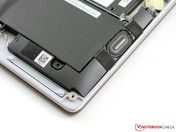
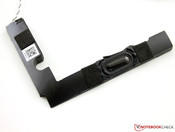
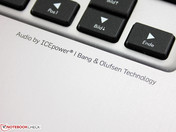
Energy Management
Power Consumption
Long battery runtimes indicate a very low power consumption in the category comparison. Is this true? It was not so for the UX32LN that ranged on the same level due to virtually identical hardware, but consumed approximately 8 Watts more in the stress test. The other competitors do not look good either, because Asus has somehow managed to keep the UX303LN's idle power consumption far below average despite its high brightness.
The small 65-Watt power supply needs almost 3:30 hours for recharging a fully drained battery (device idling).
| Asus Zenbook UX303LN-R4141H | Lenovo IdeaPad U430 Touch 59372369 | Apple MacBook Pro Retina 13 inch 2013-10 | Dell XPS 13-9333 | Gigabyte P34G v2 | Asus Zenbook UX32LN-R4029H | |
|---|---|---|---|---|---|---|
| Power Consumption | -26% | -12% | -130% | -2% | ||
| Idle Minimum * (Watt) | 3.8 | 6.7 -76% | 2.8 26% | 8.8 -132% | 3.4 11% | |
| Idle Average * (Watt) | 7.2 | 10.3 -43% | 8.8 -22% | 13.6 -89% | 7.4 -3% | |
| Idle Maximum * (Watt) | 8.4 | 10.6 -26% | 9 -7% | 21.6 -157% | 8.9 -6% | |
| Load Average * (Watt) | 41.6 | 40.7 2% | 58 -39% | 83.8 -101% | 39.7 5% | |
| Load Maximum * (Watt) | 51.9 | 45.5 12% | 60.6 -17% | 141.5 -173% | 59.6 -15% |
* ... smaller is better
| Off / Standby | |
| Idle | |
| Load |
|
Key:
min: | |
Battery Runtime
The battery life is on a record-breaking level. 13 hours while idling is naturally insignificant to the user; who would want to sit in front of the device without Wi-Fi, using the lowest brightness while at most typing in Word? The achieved 9:40 hours in the Wi-Fi browsing test is a more real-world rate. The brightness was dimmed to 140 cd/m² in energy saving mode for this test (ambient light sensor off, dimmed 6 levels). The UX32LN (50 Wh) is far from that (-36%) although it has the same capacity. The other competitors are also defeated, and only Apple's MacBook Pro Retina 13 (72 Wh) can match that.
Rendering an H.264 trailer in Full HD was possible for 7:46 hours. The brightness was also set to 140 cd/m² here, and flight mode was enabled.
| Asus Zenbook UX32LN | ||||||
|---|---|---|---|---|---|---|
| Battery runtime | -14% | 20% | 29% | -30% | -36% | |
| Reader / Idle (h) | 13 | 11.7 -10% | 25.6 97% | 16.5 27% | 7.8 -40% | |
| H.264 (h) | 7.8 | 7.8 0% | ||||
| WiFi (h) | 9.7 | 5.5 -43% | 9.5 -2% | 7.8 -20% | 4.5 -54% | 6.2 -36% |
| Load (h) | 2 | 2.2 10% | 1.7 -15% | 3.6 80% | 2.1 5% |
Verdict
Asus has once again tied up a round bundle that can thrill subnotebook fans with high demand on appearance. The casing milled from one piece of light metal feels good, and is still comfortable to carry around with a weight of 1.43 kilograms (~3.15 lb). Although the matte, FHD IPS screen cannot deliver awe-inspiring contrasts, it has a great brightness and very good color accuracy (calibrated).
An important USP of the UX303 is certainly Nvidia's GeForce 840M that makes the device fit for up-to-date top games. Despite its second heat source, the waste heat and noise emissions stay low and are even better than other competitors without a dedicated graphics card in some cases. Non-gamers can simply take the UX303LA version with integrated graphics.
The UX303LN achieves runtime of almost ten hours owing to its extremely economic idle phases, and easily outruns most of the competition from the 900 to 1200 Euro (~$1140 to $1520) price range. There is also the very good maintainability because the base plate can simply be removed after loosening the small screws - there are no hooks or buttons. A minor drawback is the poor webcam, which, however the very low-noise microphone compensates.
Very nice: Even buyers on a tight budget can take delight in a high-quality casing and decent input devices in the basic configurations (HDD, i5, HD+). However, we cannot say whether the screen with 1600x900 pixels can also achieve the high standard.

















